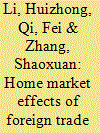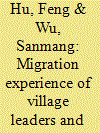|
|
|
Sort Order |
|
|
|
Items / Page
|
|
|
|
|
|
|
| Srl | Item |
| 1 |
ID:
113679


|
|
|
|
|
| Publication |
2012.
|
| Summary/Abstract |
This paper assesses both interregional and intraregional innovation inequality in China from 1995 to 2006. It is revealed that the east-central-west inequality has increased over time, whereas the inter-provincial inequality showed a V-pattern until 2003; Both inequality measures oscillated from 2004 to 2006. Using a decomposition framework recently developed by one of the authors, we determined that the major factors driving innovation inequality are population, economic development level, R&D, location and openness. The aggravated innovation inequality reflects the growth of China's innovation centers in the eastern region and their admission into the global innovation networks. The fact that R&D is a major factor driving the inequality suggests that, considered in the present study, the efficiency of R&D investment improved in certian regions during the period (1995-2006). Finally, geographic location and openness affect innovation inequality primarily through the coupled evolution of innovation capability and economic development, resulting in first-mover advantages to provinces of the eastern region.
|
|
|
|
|
|
|
|
|
|
|
|
|
|
|
|
| 2 |
ID:
113684


|
|
|
|
|
| Publication |
2012.
|
| Summary/Abstract |
This paper discusses the role of Hong Kong in China's grand scheme to build up the RMB as a global reserve currency. We highlight the economic importance of Hong Kong to China in terms of channeling foreign direct investment into China, some of which, in the future, will be denominated in the RMB. We discuss the development of China's RMB currency swap and deposit markets in Hong Kong. These offshore markets enable the RMB to trade freely, setting the stage for the RMB to become fully convertible and allowing market forces to play a role in pricing the value of the RMB, and help in the development of the RMB-denominated bond (or dim sum bond) market in Hong Kong. Finally, we present evidence of the phenomenal growth of the dim sum bond market in Hong Kong, which can further enhance and strengthen the use of the RMB outside China.
|
|
|
|
|
|
|
|
|
|
|
|
|
|
|
|
| 3 |
ID:
113682


|
|
|
|
|
| Publication |
2012.
|
| Summary/Abstract |
Social policy is an indispensable element of rule and China's current leadership has moved policy to a more inclusive system based on a notion of citizenship. The extension of social welfare provision is examined through a case study of education and health care in the South China village of Yantian. Yantian lies at the core of the Pearl River Delta, which has become a key link in the global reorganization of manufacturing and production. Consequently the village is home to some 80 000 migrant workers who complement the 3000 registered inhabitants. A study of education and health-care provision reveals that in terms of equity, registered villagers enjoy significant advantages in seeking welfare resources. Although living in the same village, the two groups inhabit "different worlds." However, provision, while selective, has become more inclusive. The present research suggests that "social citizenship" will precede "political citizenship."
|
|
|
|
|
|
|
|
|
|
|
|
|
|
|
|
| 4 |
ID:
113678


|
|
|
|
|
| Publication |
2012.
|
| Summary/Abstract |
In this paper, we use 2002-2008 International Standard Industry Classification two-digit bilateral trade panel data for manufacturing industries in China and the OECD countries to test for the existence of home market effects. We find that significant home market effects exist in 8 out of 12 industries. These industries include the food, beverage and tobacco industry, wood products, the paper products and printing industry, chemical products, other non-metallic mineral products, machinery and equipment, transport equipment, and miscellaneous products and waste resources recycling industry. Textile, clothing and leather manufacturing, oil refining and nuclear fuel manufacturing, rubber and plastics, and basic metals and fabricated metal products industries do not exhibit home market effects. Indeed, strong reverse home market effects occur for oil refining and nuclear fuel manufacturing and for the rubber and plastics industry. The empirical results reveal that certain industries benefit from new export opportunities due to the expansion of domestic demand in China.
|
|
|
|
|
|
|
|
|
|
|
|
|
|
|
|
| 5 |
ID:
113680


|
|
|
|
|
| Publication |
2012.
|
| Summary/Abstract |
This paper examines the impact of migration experience of village leaders on local economic development, based on the village-level data of the 2005 China General Social Survey. Our results show that the human capital of village leaders accumulated during the migration period has had a positive effect on per capita net income and per capita non-agricultural income in rural China. The migration experience of village leaders also plays a positive role in entrepreneurial activities in rural regions. From a policy perspective, these findings call attention to the importance of harnessing potential benefits of return migration to local economic development in rural China.
|
|
|
|
|
|
|
|
|
|
|
|
|
|
|
|
| 6 |
ID:
113681


|
|
|
|
|
| Publication |
2012.
|
| Summary/Abstract |
This article retests the separability of China's rural households in light of growing doubt about the sustainability of high economic growth in China. If a household's production decisions are "separable" from the household's consumption decisions, generally this suggests there is no surplus labor. Many scholars aver that China's surplus rural labor has spurred rapid economic growth, but concerns have arisen as to whether China still has surplus labor available. We investigate this issue using rural household panel data from 1993 to 2009 The regression results confirm that households in rural China have progressed from being non-separable to separable. The estimation results for both the entire country and regions reject the separability hypothesis before 2004 but fail to reject the hypothesis after 2004 (with the exception of the central region). These results suggest that China's surplus labor supply is dwindling, especially in the eastern and the western regions. The sustainability of China's high economic growth is questionable in the absence of a large reservoir of surplus rural labor.
|
|
|
|
|
|
|
|
|
|
|
|
|
|
|
|
| 7 |
ID:
113683


|
|
|
|
|
| Publication |
2012.
|
| Summary/Abstract |
Over the past two decades, the consumption of animal products has increased rapidly in China and India, driven by rising income and large populations. Such strong demand for animal products could have substantial impacts on both their own and global food and feed demand and supply. This paper examines the nature of rising demand for animal products in China and India and discusses national and global implications.
|
|
|
|
|
|
|
|
|
|
|
|
|
|
|
|
|
|
|
|
|